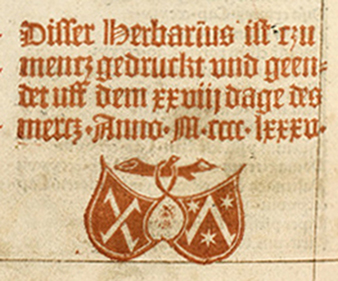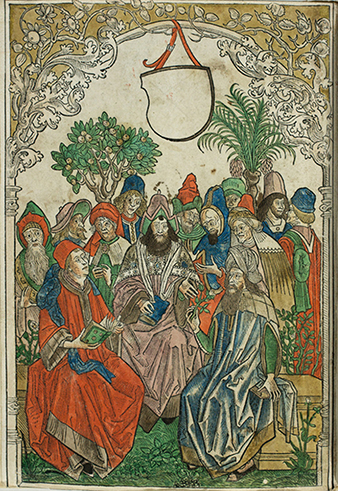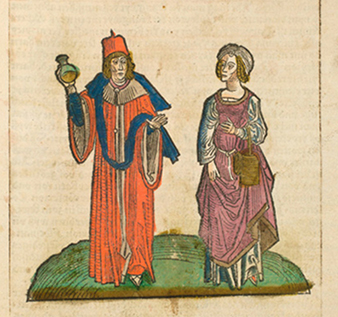Persons, Collections and Topics
Gart der Gesundheit (1485)
The Library has digitized Gart der Gesundheit (Mainz, Peter Schoeffer, 1485).
In 2019–2020 Frank A. Reynolds (photographer, 1982–1983; operations manager, 1983–1998; graphics manager, 1998–2020) photographed our hand-colored copy of Gart der Gesundheit (Mainz, Peter Schoeffer, 1485), one of the oldest books in our Library. Rachel Hunt bought this herbal in 1953, and what a prized purchase it was. This is one of nine incunabula—books printed from moveable type before 1501—in our Library, all purchased by her. From the Catalogue of Botanical Books in the Collection of Rachel McMasters Miller Hunt description: "According to the dealer, this copy comes from the botanical library of the Counts Harrach of Wien and Bruch-am-Leitha in Austria. Early Nurnberg owner's name on recto of [A1]; marginal notes in an early hand, some cropped a little" (Quinby and Stevenson 1958–1961, 1:7–8). Every incunabulum has its own interesting features, but this 1485 Gart is especially impressive. Ours is covered in soft cream suede, woodcuts are hand colored throughout, and the text has rubricated leaf numbers, text markings and a large initial letter at the beginning of each chapter. It also includes an additional handwritten index at the end.
Herbals were some of the earliest printed books in Europe, continuing a long manuscript history. Although many of the early printed herbals were in Latin—a "universal language" widely read by Western physicians, scholars and other educated persons at the time—this Gart was written in a southern German vernacular with Latin names also included. It was the first printed herbal in a German language and was the second herbal to be printed by Peter Schoeffer, following his Latin Herbarius of 1484. Publishing the more extensive Gart in vernacular German would have made the book attractive to a different readership beyond those who could read Latin.
These earliest European printed books had no title pages such as we use now—that bibliographic feature would develop in the next few decades. Some of the sort of information that would later be found on title pages was instead placed in a colophon at the end of the volume, as in the Gart's colophon with printer's mark shown here, or might be found in a preface. In terms of who made the Gart, there are a few references in the book to persons who were or may have been involved in its production. First is Peter Schoeffer (1425–1503), the publisher/printer. He had previously worked with Johann Gutenberg (ca.1400–1468) and Johann Fust (ca.1400–1466). Then, as Ellen Shaffer (1957, p. 8) noted, the Gart preface describes the book's having been commissioned by "a wealthy person, who commissioned the work to be done and employed a physician to assemble the text, while he himself made a pilgrimage in company with a painter to far lands where rare herbs were gathered and depicted with 'their true color and form.'"
Researchers increasingly believe that the person who commissioned the book and hired the writer/compiler was Bernhard von Breydenbach (ca.1440–1497), that the artist who accompanied him on a trip to the Middle East before the book was published and who drew most or all of the Gart images was Erhard Reuwich or Reeuwijk of Utrecht (fl.1480s), and that the person hired to compile and edit the text was a Frankfurt-am-Main physician, Johann von Cube (also Kaub or Cuba, fl.1484–1503). I should add that these identifications of commissioner, artist and compiler/editor seem reasonable but are unverified and some argue against them. The text was based on earlier sources—including Macer Floridus and the Buch der Natur—and edited, obscuring its origin and re-use (Keil 1986, pp. 64–65). Shaffer (1957, p. 7) pointed out a singular mention of von Cube in chapter LXXVI about Bolus Armenus or "red earth," which listed its various uses, including use as a medicine, and noted that as a medicine it "[was often employed by me, Meistern Johann von Cube]."
Lacking a title page, the Gart opens with this frontispiece showing thirteen men, perhaps physicians or other savants, together in a garden—three of them seated and in active discussion, one holding a plant and the other two with books. Shaffer (1957, p. 10) suggested that "the figures are presumably physicians versed in a knowledge of herbs, and the implication is that some of their knowledge may be found in the pages of the Gart."
The book is organized in five unnumbered sections:
- Preface
- Chapters 1–435
- Index organized by which part of the plant is used medicinally (roots, seeds, fruits, etc.)
- On Urine
- Two indexes, of maladies and Latin plant names, and the colophon at the end
Added to our copy is a nine-page handwritten index of German plant names.
The main text itself is in 435 chapters, approximately alphabetical by Latin name, with German name given alongside. The chapter numbers are printed along with the text, and in our copy the leaf numbers are written in red at the tops of the rectos. In each chapter a blank space is left at the beginning for a handwritten initial letter. Some of the initials are extensive and elegant, as in the image of the beginning of the Aloe chapter. The typography is beautiful and is spaced to accommodate the woodcuts, in some cases carefully laid out to leave space for part of an image that extends into the text, as with the Sarcocolla Kunth image.
The Gart is illustrated with 381 woodcuts (including the frontispiece and Urine section image), and many of the plant pictures are realistically drawn, such as this exuberant Paeonia Linnaeus. There are also a number of images that are much less detailed. In general, though, the 1485 Gart had seemingly the largest number of lifelike plant images in a printed herbal up to that time, predating the landmark illustrations of the 16th-century herbals of Otto Brunfels and Leonhard Fuchs by nearly five decades. There is some disagreement as to whether (and how many) images might have been copied from previous sources. However, as noted in Curtis Schuh's Annotated Bio-Bibliography (2007, entry no. 24), "the work remains a masterpiece, and is the earliest printed monument of scientific illustration." As Michael North (2015) has commented: "The text was immensely popular and came out in 14 editions before 1501." Among the herbals in our Library, most of which were collected by Rachel Hunt, this one may hold pride of place.
Following the main text there is a section on urines and uroscopy, the practice of examining a patient's urine to diagnose illness or condition. Leaf 343 recto contains this woodcut of a man and a woman. He holds a matula, a flask containing urine. She appears to be standing over what might be a urine collection contraption of some kind. Perhaps she is pregnant.
Finally, the Gart has three indexes. Between the end of the main text and the Urine chapter there is a four-page index grouping plants by which part is used medicinally, such as the roots, the seeds, the fruits, etc. Then following the Urine chapter there are two more indexes to make the text even more user friendly, one an index of maladies and the other a Latin plant name list. The colophon is printed at the end of this last index. In our copy it is followed by an additional nine-page handwritten index of German plant names on five leaves. With four indexes at hand anyone who consulted this copy of the Gart would have had excellent access to the information it contains.
Sources
Keil, G. 1986. Hortus Sanitatis, Gart der Gesundheit, Gaerde der Sunthede. In: E. B. MacDougall. 1986. Medieval Gardens. Washington, D.C.: Dumbarton Oaks.
North, M. 2015. Medieval herbals in movable type. In: E. A. Mullen, ed. 2013+. Circulating Now: From the Historical Collections of the National Library of Medicine. https://circulatingnow.nlm.nih.gov/2015/07/09/medieval-herbals-in-movable-type/.
Quinby, J. and A. H. Stevenson. 1958–1961. Catalogue of Botanical Books in the Collection of Rachel McMasters Miller Hunt. 2 vols., vol. 2 in 2 pts. Pittsburgh, Pa.: Hunt Botanical Library.
Schuh, C. 2007. Schuh's Annotated Bio-Bibliography. The Mineralogical Record. https://mineralogicalrecord.com/new_biobibliography/herbals/.
Shaffer, E. 1957. The Garden of Health: An Account of Two Herbals. ... San Francisco: Book Club of California.
This book is accessible as PDFs with a finding guide.
Gart 1485, Finding guide
Gart 1485, images 001–100
Gart 1485, images 101–200
Gart 1485, images 201–300
Gart 1485, images 301–400
Gart 1485, images 401–500
Gart 1485, images 501–600
Gart 1485, images 601–681
Gart 1485, images 682–731
![Enlarge <p>Aloe [<em>Aloe</em> Linnaeus, Asphodelaceae], hand-colored woodcut by an unknown engraver with decorative initial and other rubrication after an original by an unknown artist for <em>Gart der Gesundheit</em> (Mainz, Peter Schoeffer, 1485), HI Library call no. CA G244 RR.</p>](/admin/uploads/hibd-gart-aloe.jpg)


![<p>Pionia [<em>Paeonia</em> Linnaeus, Paeoniaceae], hand-colored woodcut by an unknown engraver after an original by an unknown artist for <em>Gart der Gesundheit</em> (Mainz, Peter Schoeffer, 1485), HI Library call no. CA G244 RR.</p>](/admin/uploads/hibd-gart-pionia.jpg)
![<p>Sarcocolla [<em>Sarcocolla</em> Kunth, Penaeaceae], hand-colored woodcut by an unknown engraver with accommodating typographical layout after an original by an unknown artist for <em>Gart der Gesundheit</em> (Mainz, Peter Schoeffer, 1485), HI Library call no. CA G244 RR.</p>](/admin/uploads/hibd-gart-sarcocolla.jpg)

